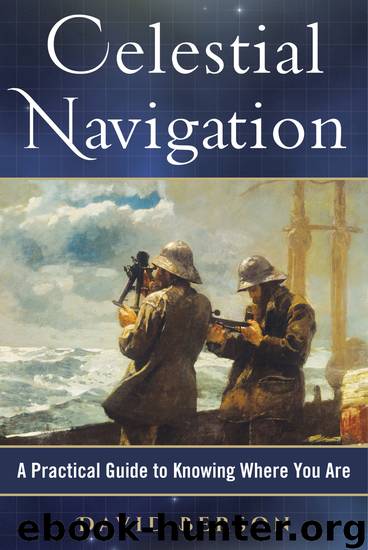Celestial Navigation by David Berson

Author:David Berson
Language: eng
Format: epub
Publisher: Seahorse
Published: 2018-07-13T16:00:00+00:00
Technique
Technique is always important, whether swinging a golf club, rowing a boat, or playing a guitar. This holds true for celestial navigation as well. In order to get the best observation of a celestial object, you should work on your technique. The classic method of celestial navigators is leaning against weather shrouds. When there is a sea running, the best thing is to sit in the main companionway hatch and make yourself comfortable. If the sun is hidden by the sails, you could ask your skipper to fall off the wind or head up a bit in order to allow you a good sight. If that is not possible, you could always trim in the headsail, back it, and heave to for a few moments. That will slow the boat down and give you a chance of not fighting too many things all at once. It is true that while sitting down, your height of eye will be reduced, but that change could be accommodated without too much trouble by using a nautical almanac, which we will get to later.
The process for taking an observation is always the same. You must always check the index error on the sextant; unless you have a plastic sextant or have dropped your more expensive metal sextant, the index error should not change. Nevertheless, it is still good protocol to check either at the beginning of or at the end of each observation. There are many methods of doing this, but the simplest is to set the index arm at 0° and the micrometer drum at 0' then look at the horizon. The reflected image of the horizon and the direct image should be a straight line.
Download
This site does not store any files on its server. We only index and link to content provided by other sites. Please contact the content providers to delete copyright contents if any and email us, we'll remove relevant links or contents immediately.
Breath by James Nestor;(2131)
The River by Peter Heller(2085)
Deep by James Nestor(2056)
Fatal Storm by Rob Mundle(2056)
Sea Survival Handbook by Keith Colwell(2027)
Lonely Planet Australia by Lonely Planet(1949)
Iced In by Chris Turney(1823)
Discover Australia by Lonely Planet(1822)
Lonely Planet Maldives (Travel Guide) by Planet Lonely & Masters Tom(1706)
One Girl One Dream by Dekker Laura(1564)
Looking for a Ship by John McPhee(1556)
Ten Degrees of Reckoning: The True Story of a Family's Love and the Will to Survive by Hester Rumberg(1533)
Chicken Soup for the Ocean Lover's Soul by Jack Canfield(1522)
Lonely Planet Australia (Travel Guide) by Lonely Planet & Lonely Planet(1496)
South with the Sun by Lynne Cox(1441)
The Wave In Pursuit of the Rogues, Freaks and Giants of the Ocean(1410)
Marlinspike Sailor's Arts and Crafts by Barbara Merry(1400)
Diver Down by Michael Ange(1400)
The Golden Rules: 10 Steps to World-Class Excellence in Your Life and Work by Bob Bowman & Charles Butler(1370)
